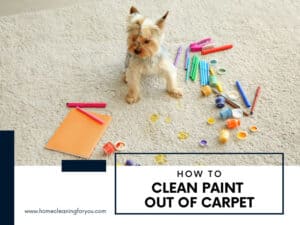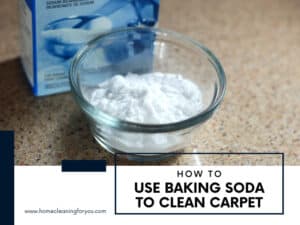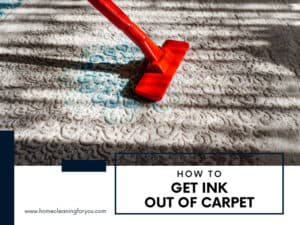Simple Ways to Remove Blood Stains from Your Carpet
Scrapes and cuts can happen from time to time. When these accidents come about, it’s not just a fresh wound that calls for treatment but also potentially a red bloodstain on your expensive and precious carpets.

Whether you’re dealing with a fresh new bloodstain or an old and stubborn one that has set in for several months, the following expert-sourced guide will prepare you with everything you need to tackle the job with little time and effort.
By the end of this stepwise guideline, you’ll figure out the essential pieces of equipment, a few tricks behind the curtain, and the most effective stain removers to restore your carpet’s beauty.
Without wasting more time, let’s get the scoop on how to get bloodstains out of your carpets!
What Are Essential Tools For Blood Stain Removal From Carpets?
There’re many different ways to get a stain off your beautiful carpet, depending on the fabric type and how stubborn the stain has formed. No matter which procedure you’re headed for, here’re some household items you’ll need to get your carpet spotless again.
Vacuum Cleaner
This equipment is extra helpful for removing the excess dirt residue after you’re done with the entire removal procedure. A wet/dry shop vac is an excellent catch for the job since it can pick up both debris, liquid, and moisture on the carpeting surface.
Towel
You’ll need one or more towels to blot the treated area and absorb the excess liquid in the process. The towel should be clean and colorfast, preferably white, to prevent the colors from transferring to the carpet while cleaning, which tends to lead to more problems to solve.
Cotton towels are the best to work with during a total carpet care regimen for long-term maintenance. However, other absorbent cloths like clean shop rags and paper towels also make good alternatives, as long as they are able to absorb as much dirt and moisture as possible.
Sponge
Sponges are easily the most absorbent material that you’ve ever used, which clearly makes them out-soak their competitors when it comes to absorbing dirt from the stains.
Not only perfect for bloodstain removal, but sponges also make other common chores such as wiping kitchen counters and cleaning vomit from carpets easy and time-saving.
Also, the smooth and soft material allows you to dab and blot the spot without leaving damages on the delicate fabrics. Since sponges are lightweight and easy to use, they’ll be great a help if you’re dealing with a large blood spill.

Broom/ Mop
If you’re there when the fresh stain has just occurred, your best bet is to clean up the messy area before it has time to settle.
However, if you come across an old and set-in bloodstain, chances are, a bit of sweeping with a microfiber mop or a classic broom prior to the treatment will help get dirt and debris out of the way for an easier and more efficient job.
Brush
Many people swear by intensive scrubbing with a harsh metal brush when it comes to tackling obstinate bloodstains.
However, this act is likely to end up ineffective. Not only does it stand a chance of pushing the stain even deeper, but it will also untwist the carpet fibers, causing them to twist and eventually damage your stunning carpeting.
Instead, you should choose a gentle brush with soft and dense bristles to work on the fibers and blot the solution away. If a carpet-specific brush doesn’t come at hand, feel free to replace it with other gentle tools such as a toothbrush or a nailbrush.
Cold Water
When cleaning up bloodstains on carpeting, it’s important that you always choose cold water as opposed to warm and hot water. This is because warm water tends to follow the blood clots faster, making the stain more tricky to remove.
What Can I Do To Remove Fresh Blood Stains?
Fresh bloodstains are undoubtedly easy to get rid of. The rule of thumb to note in mind is that the faster you act, the more effortless the bloodstain can lift off. Therefore, if an accidental blood spill just caused your carpet to turn red, follow these straightforward steps right away.
Step 1: Blot The Blood
For a fresh new bloodstain that has just occurred from a wound, you should first wipe the blood on the surface with a dry and white absorbent towel. Other tools like shop rags and cotton cloths are also perfect for absorbing loose blood.
Rather than intensive rubbing, it’s important to blot and dab gently so that you don’t cause fuzzing or changes in the fibers permanently. Also, work your way from the outside edge of the stain to prevent the blood from spreading further away.
Step 2: Moisten And Remove The Stain
Coldwater is easily the most effective aid for cleaning up fresh bloodstains. To loosen up the blood in the fibers, you can soak some garments into cold water taken from your fridge or tap and apply it onto the affected area.
Otherwise, if you have a spray bottle in hand, fill it up with cold water and lightly spritz it directly onto the stain. The water will penetrate and dilute the stain. And while you’re pressing the cloth against the spot, the blood should be gradually lifted off the carpet.
Next, repeatedly blot dry with a bit of pressure. If the stain remains, you should repeat the procedure a couple of times until it’s completely out of sight.
Step 3: Dry The Carpet
After your carpet appears to be spotless again, don’t forget to dry up the carpet before walking on it again. There’re several ways to dry a carpet in a short period of time.
However, the most efficient and convenient way to do this is by using a portable wet/dry vacuum to pick up the remaining moisture and dirt. Other than that, opening windows and turning on a high-powered fan can also create a strong airflow to dehumidify the fibers.
If you’re headed for a manual method, place some absorbent paper towels on top of the treated spot, stabilize them with heavier objects, and leave them there for a few minutes.

7 Remedies To Remove Stubborn Blood Stains From Carpets
Like any other stubborn stain situation, bloodstains are best to be taken care of as soon as possible. Unlike casual dirt and debris that can be cleaned up with a commercial carpet cleaner in no time, these protein stains call for specialized cleaning aids to disappear.
Though set-in stain removals can be a bit of a hassle, you can still tackle this task effectively using these tried-and-true solutions as follows.
Method 1: Hydrogen Peroxide
As a mild bleach, this medicine staple is renowned for its ability to remove tough stains while remaining entirely safe when coming in contact with your clothes or skins. If you come across a dried stain or a large blood spill, this remedy is your best bet to turn to.
On a separate note, since not all carpets are created equal, hydrogen peroxide works best on flat-colored and white carpets rather than multi-colored ones.
For a multi-dyed carpet that calls for immediate treatment, you can attempt to test it on a small and hidden spot of your carpet ahead of time to make sure the peroxide doesn’t cause any discoloration.
- Step 1: Test a few drops of peroxide on an inconspicuous patch to see how the carpet reacts.
- Step 2: If no damages or discolorations occur, you’re good to soak a cotton swab in hydrogen peroxide.
- Step 3: Carefully place the swab directly onto the stain to make sure it doesn’t spread out.
- Step 4: Let it sit for approximately an hour.
- Step 5: Remove the swab and use a wet washcloth to blot the area until the stain is completely gone.
- Step 6: Rinse the treated area and let it air-dry.
Getting rid of a stubborn bloodstain on carpets should be a breeze with hydrogen peroxide! Watch this video to know more:
Method 2: Baking Soda
Baking soda is a trusty pantry cleaner that can be found in most homeowner’s stock. Thanks to its mild abrasiveness and alkalinity, this ingredient works in more than one way to help you clean up your carpet.
Besides serving as a separator of the proteins in a bloodstain, baking soda is also utilized as a deodorizer and a disinfectant, making it well-suited for this job. By creating a simple baking soda and water paste, you should get your carpet spotless again in no time.
- Step 1: Combine three teaspoons of baking soda and a cup of water, thoroughly stir the mixture until it turns into a dense paste.
- Step 2: Apply the paste onto the stain and let it dwell for 1 hour, or better yet, overnight.
- Step 3: Use a soft rag to blot the treated area gently.
- Step 4: Add a bit of water if the stain remains stubborn and continually blot until it’s entirely lifted out.
- Step 5: Take out a multi-surface vacuum cleaner to get rid of the moisture and debris.
- Step 6: Leave the treated surface to dry.
For a more visualized demonstration, this is the expert-guided way to clean up bloodstains on carpets with baking soda. Watch this video to know more:
Method 3: Salt
If the stain still remains present after you’ve tried the previous remedies, a salt paste is a quick yet super-efficient solution that you can use to tackle tough bloodstains. This solution excels with delicate linens but also proves to be effective on others like carpeting and rugs.
However, if you plan to clean your carpet using this staple, you should always vacuum or use a sponge mop to collect all the salt residues after the work is finished. Otherwise, it’ll leave a powdery residue that damages the carpet fibers and attract more dirt once melted.
- Step 1: Pour a small volume of cold water and add three tablespoons of salt into a bowl.
- Step 2: Whip the mix until it forms a thin paste.
- Step 3: Apply this salt paste to the stain and let it sit for up to 5 minutes.
- Step 4: Without scrubbing, which may cause the stain to spread further, lightly dab the patch with some cotton towel or cloth.
- Step 5: Repeat this process until you’re satisfied with the final result.
- Step 6: Once finished, take a broom or a small shop vac to clean up the salt residue and let the treated area dry.
Method 4: Shaving Cream
While it may sound odd to some homeowners, shaving cream is, in fact, one of the most economical and effective methods to get rid of bloodstains on your carpet.
Since this item is actually a form of whipped soap, it can penetrate and add moisture to just about any unfortunate stain, thusly makes carpet upkeep a breeze.
It’s best to use plain white varieties of shaving cream. But if these aren’t at your disposal when the stain occurs, other types like gel-based, colored, and menthol shaving creams will also make great alternatives in a pinch. You need to test it on a small patch prior to the treatment.
- Step 1: Spray the shaving cream over the affected area.
- Step 2: Let it sit for about 15-20 minutes, or preferably, overnight.
- Step 3: Use a soft-bristled brush and lightly scrub the cream off the stain from the outer edge towards the middle. Don’t intensively rub, as this can damage the carpet fibers and spread the stain.
- Step 4: Rinse out the remaining cream with a vinegar-and-water solution.
- Step 5: Take a cotton cloth and blot the stain dry until it disappears.
- Step 6: Use a household vacuum cleaner to eliminate the remains of cream, dirt, and moisture.
Method 5: Ammonia
For an old and dried bloodstain that has formed for months or even years before discovered, you may need a stronger chemical cleaner to restore your carpet’s former beauty. Ammonia is an alkaline solution that really helps cut off obstinate stains for good.
On a side note, since ammonia is particularly high in alkalinity, it shouldn’t be applied on wool rugs and carpets to avoid unwanted damages. Also, this ingredient can never be mixed with chlorine bleach since the resulting fumes are hazardous and potentially lethal to humans.
When you’re working with an ammonia solution, make sure to get the treated area well-ventilated by opening all windows and doors. And for maximum safety, personal protections like gloves and eyewear are recommended during the entire session.
- Step 1: Put together one teaspoon of ammonia and one-half cup of water.
- Step 2: Use a cotton swab or sponge to apply the mixture onto the stain.
- Step 3: Repeatedly blot the spot until the liquid is entirely absorbed into the fibers.
- Step 4: Dip a clean sponge into some cold water and apply it directly onto the spot.
- Step 5: Blot it dry with another clean cloth or towel.
- Step 6: Repeat this process until the stain has completely disappeared.
Method 6: Dishwashing Detergent
If you’re dealing with a fresh blood spill that has just set in from an accident on the spot, your best bet may be to go with this classic technique. Normally, a mild liquid detergent or dish soap that doesn’t contain bleach or lanolin will get the job done with ease.
- Step 1: Combine one teaspoon of liquid detergent with two cups of cold water.
- Step 2: Take a clean cotton cloth or sponge to apply this solution onto the stained area.
- Step 3: Continually blot the stain until the liquid is absorbed into the carpeting.
- Step 4: Use a soft-bristle brush or toothbrush to gently scrub the stain until it’s gone.
- Step 5: Rinse the treated area with a dampened cloth.
- Step 6: Blot it dry until there’re no grimy residues left on the carpet.
Let’s see how the expert cleans up a blood spill on carpets with some common dishwashing detergent.
Method 7: Potato Starch
If your expensive and precious carpet has become a victim of bloodstains, and you don’t want to interrupt with any chemical solution that may discolor the dyed fabrics, a quick fix with potato starch is certainly your game-changer.
Other than its usage for baked goods and soups, potato starch is actually a carbohydrate medium that has some acidity in its nature. When paired with a protein stain like blood, this ingredient causes an enzymatic dissociation process that allows for fast and easy removal.
- Step 1: Wipe off the excess blood on the stain and dissolve the remaining with water.
- Step 2: Dab a soft cotton cloth or swab on the treated spot and blot it dry to soak up the liquid.
- Step 3: Sprinkle some potato starch to cover the entire stain and give it 24 hours to sit.
- Step 4: Take out your suction vacuum cleaner and go over the area to collect the dirt residues.

Best Way To Get Blood Stains Out Of Wool Carpets
Pure wool and wool mix carpets are popular for their interesting visual appeal, texture, and super-soft comfort to the touch.
If you plan to perform a stain removal procedure on your woolen carpets, keep in mind that these pieces are highly sensitive to harsh chemical solutions like ammonia and hydrogen peroxide.
Your best bet to remove bloodstains without leaving permanent damages or discoloration is to use a wool-approved carpet cleaner and strictly follow the manufacturer’s directions.
On the other hand, if you’d go for a homemade green cleaning aid, a simple mix of white vinegar and cold water will excel at this task. Mix two cups of water with a quarter cup of vinegar into a spray bottle.
Then, spritz the treated spot with this mixture and use a soft cloth to gently blot it. Repeat these steps until you’re satisfied with the outcome, and use a vacuum for wool carpet to clear out any grime and moisture left.
Extra Tips To Clean Blood Out Of Carpets
With proper treatments, whenever an accident happens that leaves some bloodstains on it, your carpeting can retain its quality and aesthetic appeal for a lifetime of use. Here, I’ve compiled some tried-and-true tips to help you tackle this job without a hitch.
Clean Before It Dries
It goes without saying that the more speedily you act when a bloodstain is in sight, the easier and more effort-saving it will be to tackle the job.
While a fresh stain takes little labor and a straightforward solution to completely disappear, old and set-in stains tend to take elbow grease and stronger methods.
Use Cold Water
Though hot water is effective for juice and liquid removal, even moderately lukewarm water poses a risk of cooking the blood and cause the stain to permanently set in. Therefore, you should prepare a bucket or a bowl of cold water, either taken from your tap or fridge.
Avoid Aggressive Scrubbing
While cleaning up a bloodstain from your carpeting most likely takes elbow grease and some time, it would be quite a mistake to try to speed it up by intensive rubbing and scrubbing.
This is because as you perform these aggressive techniques against the carpet, you run the risk of causing fuzzing and damages to the fabrics. If you’re tackling a fresh new stain, the blood spill can also be spilled to the flooring surface.
Therefore, the best approach is to gently dab and blot the stain with a bit of pressure. This will allow both the blood and dirt to be absorbed in your towel or cloth, thusly restore your carpet’s former damage-free beauty.
If you’re unclear about how gentle you should work on the carpet, here’s a comprehensive demonstration from a professional.
Watch this video to know more:

Work Inward From The Edges
With the right tool and cleaning solution in hand, it’s important to always blot from the outside in. In other words, always work from the outer edges from the stain toward its center.
This technique should help you to cover up the entire treated area effectively without spreading the stain further and wider.
Test It First
As carpets come in a wide variety of textures, materials, colors, and styles, it’s safe to say that no stain removal procedure is applicable to all carpeting varieties.
To make sure that the removal method that you choose causes no harm or discoloration on your carpet, you can pre-test it on a small and inconspicuous patch of the carpet and see how it reacts prior to the real treatment.
Dry The Carpet
Once your carpet is all clean and spotless, make sure to use a shop vacuum to get rid of any remaining dirt, moisture, and liquid.
If you’re getting the carpets spotlessly clean without a vacuum, another manual yet effective method is to place some paper towels over the affected area and weigh them down with some heavy items like books and tables.
This is because if left saturated in water for too long, wet carpet may result in permanent water damages. Plus, wet carpets are also breeding grounds for dangerous mildew, mold, and bacteria.
So for your own safety and your carpet’s long-term quality, especially if you own a thick carpet, dry it up properly with a vacuum cleaner for high-pile carpets before walking on it again.
Get Professional Care
It’s safe to say that not all carpets are created equal in materials and qualities. If your precious and exquisite carpets are made out of delicate materials like silk, antique, or partly silk, it’s best to call for professional help so that you don’t pose any risk of ruining your piece of décor.
What’s more, if you’ve tried some recommended techniques above and still struggle with the obstinate blood residue, chances are, you’ll be better off leaving the task to expert carpet cleaners.
However, if you’re determined to remove the bloodstain on your own, it’s best to opt for a specialized cleaner and vacuum. For instance, use a Berber carpet-approved for your ancient-styled Berber carpet instead of a common household one.
Frequently Asked Questions
Scrapes and cuts happen from time to time, and it’s best if you learn the basics of how to remove bloodstains from your carpets if an accidental blood spill occurs. To get you well-prepared for this task, these expert-sourced questions will clear up any queries you may have.
Expectations Vs. Reality
As we draw today’s guide to an end, I hope you’ve been well-prepared with the following methods and tips on how to get bloodstains out of carpets.
Whether your exquisite carpets are made from natural or synthetic materials, there’s sure to be a cleaning aid that can get your piece of décor spotlessly clean again.
On a more important note, you should remember to use natural cleaning solutions for pure wool and wool mix carpets. And if you’re dealing with synthetic fibers, mild bleaching or enzymatic cleaners should get the job done beautifully.
With my expert-sourced guide above, you can get rid of any accidental bloodstains from your carpets like a pro from now on. If there’s any other home remedy that you’ve tried in the past, feel free to share it with me in the comment section right below!








Kevin Jones
Founder & Chief Home Organization Strategist
Expertise
Home Organization & Decluttering, Efficient Cleaning Methods & Stain Removal, Sustainable Cleaning Practices, DIY Home Maintenance & Repairs, Space Optimization & Storage Solutions, Budget-Friendly Home Care Strategies
Education
University of Texas at Austin
Kevin Jones is the Founder and Chief Home Organization Strategist at HomeCleaningForYou.com.
He earned a Bachelor of Science in Interior Design from the University of Texas at Austin, focusing on space planning and sustainable design. Specializing in home organization, decluttering, and budget-friendly home care, he helps homeowners create functional and stylish spaces.
Kevin has been featured in lifestyle publications and has collaborated with eco-friendly brands on home organization solutions. He shares his expertise through DIY guides, workshops, and online tutorials. Passionate about minimalism, he enjoys testing new organization methods and exploring sustainable living ideas.